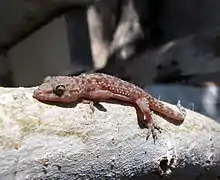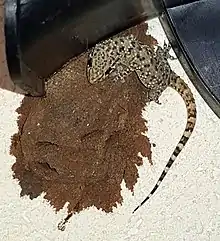Mediterranean house gecko
The Mediterranean house gecko (Hemidactylus turcicus) is a type of house gecko common to the Mediterranean area which has spread to many parts of the world. It is commonly referred to as the Turkish gecko[1] as represented in its Latin name and also as the moon lizard because it emerges in the evening.
| Mediterranean house gecko | |
|---|---|
 | |
| Scientific classification | |
| Kingdom: | Animalia |
| Phylum: | Chordata |
| Class: | Reptilia |
| Order: | Squamata |
| Family: | Gekkonidae |
| Genus: | Hemidactylus |
| Species: | H. turcicus |
| Binomial name | |
| Hemidactylus turcicus | |
 | |
A study in Portugal found H. turcicus to be totally nocturnal, with the highest activity peak around 2:00 AM.[2] They are insectivorous, rarely exceeding 15 centimetres (5.9 in) in length, have large, lidless eyes with elliptical pupils, and purple - or tan-colored skin with black spots, often with stripes on the tail. Their bellies or undersides are somewhat translucent. It is currently unknown what impact the geckos have on native wildlife in the regions they have been introduced to.[3]
In many parts of the world the range of H. turcicus is increasing,[1] and unlike many other reptiles, they appear to be highly resistant to pesticides. The increase may be explained as a consequence of having few predators in places where they have been introduced, and also of their tendency to take shelter in the cracks and unseen areas of human homes, for example inside walls. Reliance on human habitation has thus contributed to their proliferation, similar to rodents. In some Eastern Mediterranean countries such as Turkey and Cyprus it is a taboo to harm them due to their benign nature and they are often kept as house pets.
Description


Snout rounded, about as long as the distance between the eye and the ear opening, 1.25 to 1.3 the diameter of the orbit; forehead slightly concave; ear-opening oval, oblique, nearly half the diameter of the eye. Body and limbs moderate. Digits variable in length, the inner always well developed; 6 to 8 lamellae under the inner digits, 8 to 10 under the fourth finger, and 9 to 11 under the fourth toe. Head with large granules anteriorly, posteriorly with minute granules intermixed with round tubercles. Rostrum four-sided, not twice as broad as deep, with medial cleft above; nostril pierced between the rostrum, the first labial, and three nasals; 7 to 10 upper and 6 to 8 lower labials; mental large, triangular, at least twice as long as the adjacent labials, its point between two large chin-shields, which may be in contact behind it; a smaller chin shield on each side of the larger pair. Upper surface of body covered with minute granules intermixed with large tubercles, generally larger than the spaces between them, suboval, trihedral, and arranged in 14 or 16 pretty, regular longitudinal series. Abdominal scales small, smooth, roundish-hexagonal, imbricate. Males with a short angular series of 4 to 10 (exceptionally 2) preanal pores. Tail cylindrical, slightly depressed, tapering, covered above with minute scales and transverse series of large keeled tubercles, beneath with a series of large transversely dilated plates. Light brown or grayish above, spotted with darker; many of the tubercles white, lower surfaces white.[4] They may be completely translucent except for the spotting. Some are darker. They often seek darkness when fleeing. They may be seen singularly or in a group ranging from 2 to 5 together.
Geographic distribution

Native to the Mediterranean region, the "Med gecko" is one of the most successful species of geckos in the world. It has spread over much of the world and established stable populations far from its origins; it holds no threatened or endangered status. It can be found in countries with Mediterranean climates,[5] such as Portugal, Spain, France, Italy (including Lampedusa Island, Elba), Israel, Albania, Greece, Malta, North Macedonia, coastal Croatia (except western Istria), the Czech Republic (only the warm parts of Moravia and Czech Silesia), Bosnia and Herzegovina, the Adriatic islands, coastal Montenegro, the coastal part of Albania, Cyprus, Turkey, northern Morocco, Algeria, Tunisia, Jordan, Syria, Libya, Egypt, Lebanon, northern Yemen (the Socotra Archipelago), Somalia, Eritrea, Kenya, southern Iran, Iraq, Oman, Qatar, Pakistan, India, the Balearic Islands (Island Addaya Grande), the Canary Islands (introduced to Gran Canaria and Tenerife), Panama, Puerto Rico, Belize, and Cuba.
In Mexico, introductions are known from the states of Tamaulipas, Veracruz, Tabasco, Campeche, Yucatán,[6] Baja California,[7] Chihuahua, Coahuila, Sonora,[8] Durango,[9] and Nuevo León.[10] Introductions are also known from across the Southern U.S., where it is particularly well-established in the Gulf Coast states, including Alabama, Arizona, Arkansas, California,[5] Florida, Georgia, Kansas, Kentucky, Louisiana, Maryland, Mississippi, Missouri, Nevada, New Mexico, North Carolina, Ohio, Oklahoma, South Carolina, Texas, and Virginia.[7][11] It can also be occasionally found as far north as Tennessee and Utah..
Behaviour

Mediterranean house geckoes emit a distinctive, high-pitched call somewhat like a squeak or the chirp of a bird, possibly expressing a territorial message. They are voracious predators on moths and small roaches, and are attracted to outdoor lights in search of these prey. They are also attracted by the call of a male decorated cricket (Gryllodes supplicans) even though the males are usually safely out of reach in a burrow, because female crickets attracted to the male's call can be intercepted and eaten.[12]
See also
Notes
- Agasyan, A.; Avci, A.; Tuniyev, B.; Isailovic, J. C.; Lymberakis, P.; Andrén, C.; Cogalniceanu, D.; Wilkinson, J.; Ananjeva, N.; Üzüm, N.; Orlov, N.; Podloucky, R.; Tuniyev, S.; Kaya, U.; Vogrin, M.; Corti, C.; Mellado, V. P.; Sá-Sousa, P.; Cheylan, M.; Pleguezuelos, J.; El Din, S. B.; Tok, C. V. (2009). "Hemidactylus turcicus". IUCN Red List of Threatened Species. IUCN. 2009: e.T157261A5063993. doi:10.2305/IUCN.UK.2009.RLTS.T157261A5063993.en. Retrieved 5 December 2019.CS1 maint: uses authors parameter (link)
- Mateus, O. & Jacinto, J.J. (2002): Contribution to the study of Hemidactylus turcicus (Reptilia, Gekkonidae): rhythms of activity and microhabitat in Évora, Portugal. P. 136, in S.P.H. [Sociedade Portuguesa de Herpetologia] & A.H.E. [Associación Herpetológica Española] (coord.) Livro de resumos do VII Congresso Luso-espanhol de Herpetologia / XI Congreso Español de Herpetologia. S.P.H. & A.H.E.. Évora, Portugal.
- "Species Profile: Mediterranean Gecko (Hemidactylus turcicus) | SREL Herpetology". srelherp.uga.edu. Retrieved 2019-05-24.
- Boulenger, G. A. (1890) Fauna of British India. Reptilia and Batrachia.
- "Texas Invasives".
- Smith, H. M. and E. H. Taylor. 1966. Herpetology of Mexico: Annotated Checklist and Keys to the Amphibians and Reptiles. A reprint of Bulletins 187, 194 and 199 of the U. S. Nat. Mus. with a list of subsequent taxonomic innovations. Eric Lundberg, Ashton, Maryland.
- Stebbins, R. C. and S. M. McGinnis 2018. Peterson Field Guide to Western Reptiles and Amphibians. 4th ed.. Houghton Mifflin Harcourt Company, Boston, New York. xi, 560 pp. ISBN 9781328715500
- Lemos Espinal, J. A., G. R. Smith, J. R. Dixon, and A. Cruz. 2015. Amphibians and Reptiles of Sonora, Chihuahua, and Coahuila, Mexico. CONABIO, Mexico D. F. 668 pp. ISBN 978-607-8328-27-7
- Lemos Espinal, J. A., G. R. Smith, and R. Valdez Laresz. 2019. Amphibians and Reptiles of Durango, Mexico. Eco Herpetological Publishing and Distribution. Rodeo, New Mexico. xii, 416 pp. ISBN 978-1-938850-27-1
- Lemos Espinal, J. A., G. R. Smith, and A. Cruz. 2018. Amphibians and Reptiles of Nuevo León. Eco Herpetological Publishing and Distribution. Rodeo, New Mexico. x, 370 pp. ISBN 978-1-938850-25-7
- Powell, R, R. Conant, and J. T. Collins (2016). Peterson Field Guide to Reptiles and Amphibians of Eastern and Central North America, 4th ed. Houghton Mifflin Co., Boston, Massachusetts. xiii, 494 pp. ISBN 978-0-544-12997-9
- Matthews, Robert W.; Matthews, Janice R. (2009). Insect Behavior. Springer Science & Business Media. pp. 314–319. ISBN 978-90-481-2389-6.
References
- Franklin, Carl J. 1997 Geographic Distribution. Hemidactylus turcicus. Herpetological Review 28 (2): 96
- Burke, Russell L. 1996 Geographic Distribution. Hemidactylus turcicus. Herpetological Review 27 (1): 32
- Davis, W.K. 1974 The Mediterranean gecko, Hemidactylus turcicus in Texas J. Herpetol. 8(1): 77–80.
- Dowling, Richard G. 1996 The Mediterranean Gecko, Hemidactylus turcicus, in Prattville, Alabama Bulletin of the Chicago Herpetological Society 21 (11): 203
- Dundee, H. A. 1984 Hemidactylus turcicus (Mediterranean gecko) Herp Review 15 (1): 20
- Frick, Michael G. 1997 Geographic Distribution. Hemidactylus turcicus Herpetological Review 28 (1): 50
- Husak, Jerry F. 1996 Geographic Distribution. Hemidactylus turcicus Herpetological Review 27 (4): 211
- Jensen, Steve L.;George, Steven G. 1993 Hemidactylus turcicus (Mediterranean gecko). USA: Louisiana Herpetological Review 24 (4): 154
- Knight, C. Michael 1993 A northern range extension of Hemidactylus turcicus in the United States Dactylus 2 (2): 49-50
- Means, Ryan C. 1999 Geographic distribution. Hemidactylus turcicus Herpetological Review 30 (1): 52
- Proudfoot, Glenn;McCoid, Michael James 1996 Geographic Distribution. Hemidactylus turcicus Herpetological Review 27 (2): 87
- Ray, John;Cochran, Betsy 1997 Geographic Distribution. Hemidactylus turcicus Herpetological Review 28 (3): 157
- Williams, Avery A. 1997 Geographic Distribution. Hemidactylus turcicus Herpetological Review 28 (2): 96
External links
| Wikimedia Commons has media related to Hemidactylus turcicus. |
- Hemidactylus turcicus at the Reptarium.cz Reptile Database
- Institut für Biowissenschaften: H. turcicus image
- Species Profile: Mediterranean Gecko by the Savannah River Ecology Laboratory
- Nonnatives: Mediterranean Gecko by the Florida Fish and Wildlife Conservation Commission
